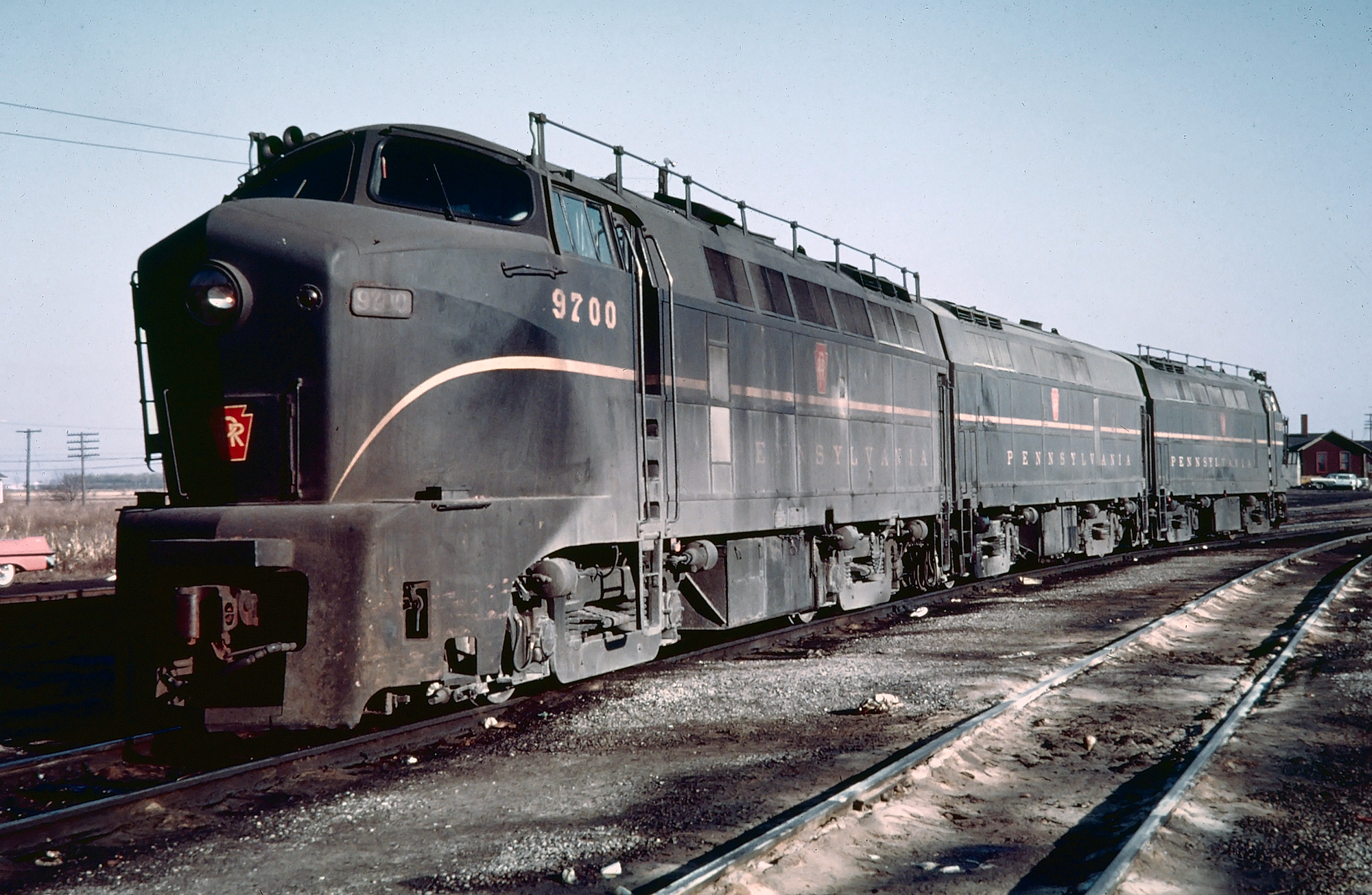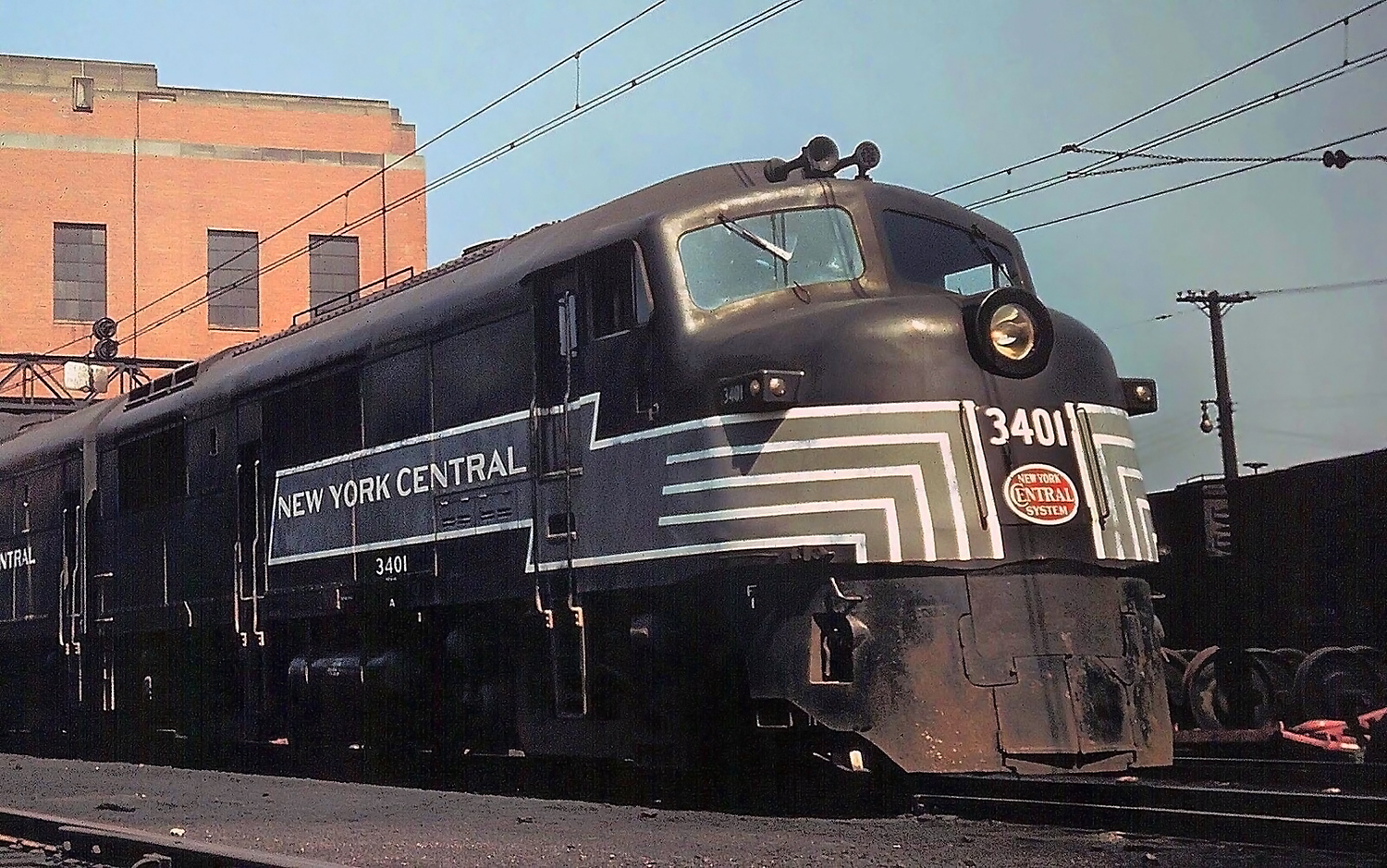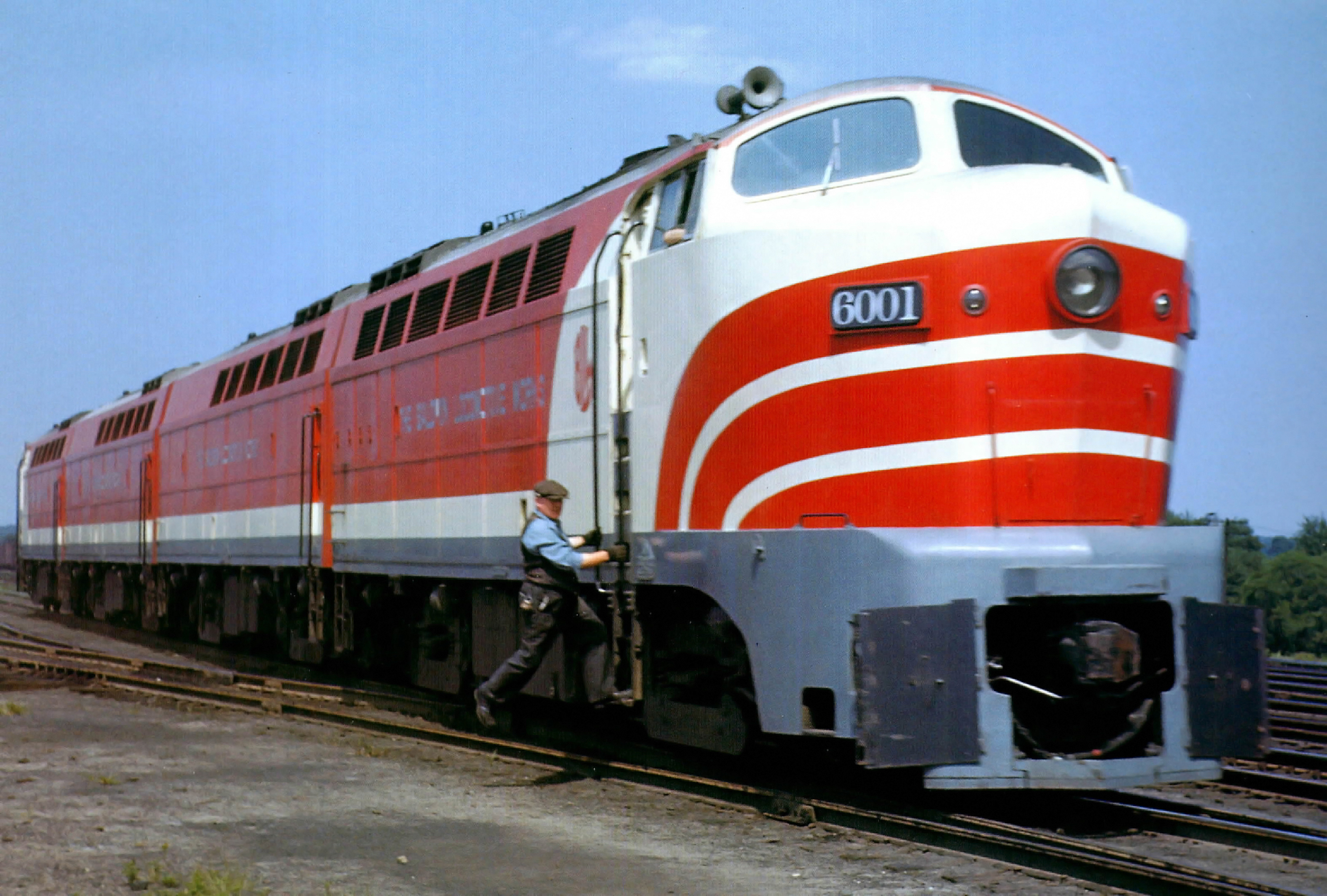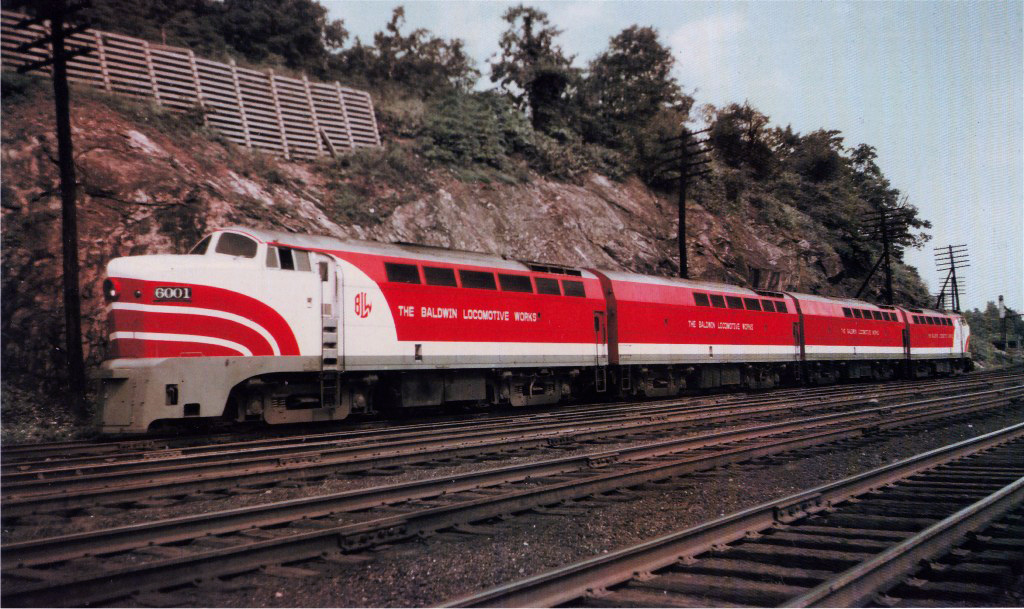Baldwin "DR-4-4-1500" Locomotives: Specs, Roster, Data Sheet
Last revised: December 28, 2024
By: Adam Burns
The DR-4-4-1500 was the first domestically produced cab freight unit Baldwin offered in an effort to compete against Electro-Motive's extremely successful F series.
Baldwin used two carbody styles for its road freight units; the original "Baby Face" design and later the more striking "Sharknose" design.
At least one version could be found on several models including the DR-4-4-1500, DR-6-4-1500, DR-6-4-2000, and finally the RF-16 (offered only in the "Sharknose" carbody).
The latter was part of the builder's new "Standard Line" released in the early 1950's. Baldwin faced reliability issues with its early models; coupled with an unattractive design the company sold few DR-4-4-1500s.
By the time production had ended just over 100 A and B units rolled out of Eddystone (most of which were purchased by the PRR).
Photos
 An A-B-A set of Pennsylvania's handsome Baldwin cab units in the "Sharknose" carbody, including DR-4-4-1500 #9700 and RF16A #9725, layover in Toledo, Ohio on March 7, 1963. Fred Byerly photo. American-Rails.com collection.
An A-B-A set of Pennsylvania's handsome Baldwin cab units in the "Sharknose" carbody, including DR-4-4-1500 #9700 and RF16A #9725, layover in Toledo, Ohio on March 7, 1963. Fred Byerly photo. American-Rails.com collection.Overview
The DR-4-4-1500 began production in November, 1947 using a carbody design that can only be described as unique.
Similar to EMD's cab units that carried a streamlined look with a sloped front nose ahead of the crew cab, the DR-4-4-1500 wore something similar.
The most noticeable difference was the nose; EMD's was much higher, sporting narrower windshields which molded to the carbody's overall appearance.
By contrast, the DR-4-4-1500 featured a lower nose with larger, wider windshields. The appearance earned it the nickname "Baby Face" by railfans and train enthusiasts.
Reception
From the start, the DR-4-4-1500 was intended for freight service as a direct competitor against similar models from Electro-Motive (F series) and American-Locomotive (FA).
If there was an area in which Baldwin struggled immensely, it was the cab market. The builder found few buyers for either its original "Baby Face" variant or later "Shark Nose" design.
In addition, it was nearly a decade late in releasing a cab design to complete against Electro-Motive. To Baldwin's credit, the builder continued refining its locomotives. The RF16, for example, was much more successful.
 New York Central DR-4-4-1500 #3401 sits outside the shops at the railroad's major terminal in Collinwood, Ohio during May of 1950. Ed Nowak photo.
New York Central DR-4-4-1500 #3401 sits outside the shops at the railroad's major terminal in Collinwood, Ohio during May of 1950. Ed Nowak photo.It is interesting to wonder what may have happened if Baldwin weathered its initial poor performance selling diesel locomotives. The builder's "Standard Line" was growing in demand when parent Westinghouse pulled Baldwin out of the locomotive market.
The DR-4-4-1500 (or, DR-4-4-15) utilized the builder's original 608SC prime mover. The DR-4-4-1500 could produce 1,500 horsepower and featured a B-B truck setup (two axles per truck).
Model Classification
Since Baldwin was still building a few steam locomotives when the DR-4-4-1500 was released, the company continued to utilize a version of the "Whyte Notation" classification system from the steam era.
For example, the model's numbers and letters referred to the following:
- Diesel Road unit
- The first 4 referred to four overall axles
- The second 4 regarded four powered traction motors
- 1,500 indicated the horsepower rating
 The A-B-B-A demonstrator set of Baldwin's DR-4-4-1500 are seen here at Maybrook Yard (New York) testing on the Lehigh & Hudson River, circa 1949. This is the later version of the model wearing the "Sharknose" carbody, which replaced the earlier "Baby Face" design.
The A-B-B-A demonstrator set of Baldwin's DR-4-4-1500 are seen here at Maybrook Yard (New York) testing on the Lehigh & Hudson River, circa 1949. This is the later version of the model wearing the "Sharknose" carbody, which replaced the earlier "Baby Face" design.The "Baby Face" design did not last long. Realizing it was unpopular, Baldwin contracted with Hadley, Ryder & Pedersen for a complete carbody redesign.
The company came up with the classic "Sharknose" concept, which gave Baldwin's late-era cab locomotives an entirely unique look.
Hadley, Ryder & Pedersen was also tasked with arranging the interior equipment, stress analysis of the carbody, and working with Baldwin in the final overall design.
Contrary to popular railfan belief, the Sharknose was not a Raymond Loewy design. As John Kirkland points out in his book, "The Diesel Builders: Volume Three (Baldwin Locomotive Works," this idea likely derived from the carbody's similarity to Pennsylvania Railroad's streamlined 4-4-4-4 "Duplex Drive" T-1's.
The angular nose of these famous steam locomotives, which as a Lowey inspiration, bore a striking resemblance to the Sharknose carbody.
Internally, the DR-4-4-15 featured components from Westinghouse Electric, which supplied Baldwin with virtually all of its internal equipment for its diesel models (the two companies had been working in conjunction since the 19th century).
As for tractive effort, the original "Baby Face" variant ranged from 28,100 to 42,800 continuous depending upon the gearing chosen.
Gearing Options
| Gear Ratio | Maximum Speed | Continuous Tractive Effort (Lbs) | Continuous TE Rating Speed |
|---|---|---|---|
| 15:63 | 65 | 42,800 | 10.5 |
| 17:62 | 75 | 37,200 | 12.2 |
| 19:60 | 82 | 32,200 | 14.0 |
| 20:59 | 87.5 | 30,000 | 15.0 |
| 21:58 | 93.5 | 28,100 | 16.0 |
Data Sheet and Specifications
"Baby Face"
| Entered Production | 11/11/1947 (Jersey Central #70-71 [As] and #K [B]) |
| Years Produced | 11/11/1947 - 12/30/1948 |
| Baldwin Class | DR-4-4-1500/1 SC |
| Engine | 608SC |
| Engine Builder | De La Vergne |
| Horsepower | 1500 |
| RPM | 625 |
| Carbody Styling | Baldwin |
| Length (Between Coupler Pulling Faces) | 53' 6" |
| Weight | 250,000 Lbs |
| Trucks | B-B |
| Truck Type | GSC Swing Bolster, Drop-Side Equalizers |
| Truck Wheelbase | 9' 10" |
| Wheel Size | 42" |
| Traction Motors | 370F (4), Westinghouse |
| Traction Generator | 471A, Westinghouse |
| Auxiliary Generator | YG42A, Westinghouse |
| Gear Ratio | 15:63* |
| Tractive Effort Rating | 42,800 Lbs at 10.5 MPH. |
| Top Speed | 65 MPH |
* All DR-4-4-1500's of the "Baby Face" carbody were purchased with the 15:63 gearing although the options mentioned in the first table were available.
Following completion of the Jersey Central units, Baldwin rearranged equipment within the "A" units which increased their length to 55' 6". The "B" units length remained unchanged.
"Shark Nose"
| Entered Production | 2/28/1949 (Pennsylvania #9568 [A] and #9568B-9569B [Bs]) |
| Years Produced | 2/28/1949 - 6/9/1950 |
| Baldwin Class | DR-4-4-1500/1 SC |
| Engine | 608SC |
| Engine Builder | De La Vergne |
| Horsepower | 1500 |
| RPM | 625 |
| Carbody Styling | Baldwin |
| Length (Between Coupler Pulling Faces) | 54' 8" (A units), 53' 22" (B units) |
| Weight | 250,000 Lbs |
| Trucks | B-B |
| Truck Type | GSC Swing Bolster, Drop-Side Equalizers |
| Truck Wheelbase | 9' 10" |
| Wheel Size | 42" |
| Traction Motors | 370F (4), Westinghouse |
| Traction Generator | 471A, Westinghouse |
| Auxiliary Generator | YG42A, Westinghouse |
| Gear Ratio | 15:63 |
| Tractive Effort Rating | 42,800 Lbs at 10.5 MPH. |
| Top Speed | 65 MPH |
Pennsylvania units #9705A-9707A and #9704B-9705B were upgraded with a YG42B auxiliary-exciter generator and 370GL traction motors.
Production Rosters
Total Built = 105
"Babyface"
| Owner | Road Number | Baldwin Serial Number (A Unit) | Baldwin Serial Number (B Unit) | Construction Number | Completion Date |
|---|---|---|---|---|---|
| Central Railroad Of New Jersey | 70 | 1 | 73114 | 11/11/1947 | |
| Central Railroad Of New Jersey | K | 1 | 73124 | 11/11/1947 | |
| Central Railroad Of New Jersey | 71 | 2 | 73115 | 11/11/1947 | |
| Central Railroad Of New Jersey | 72 | 3 | 73116 | 7/1/1948 | |
| Central Railroad Of New Jersey | L | 2 | 73125 | 7/1/1948 | |
| Central Railroad Of New Jersey | 73 | 4 | 73117 | 7/1/1948 | |
| Central Railroad Of New Jersey | 74 | 5 | 73118 | 8/20/1948 | |
| Central Railroad Of New Jersey | M | 3 | 73126 | 8/20/1948 | |
| Central Railroad Of New Jersey | 75 | 6 | 73119 | 8/20/1948 | |
| Central Railroad Of New Jersey | 76 | 7 | 73120 | 9/9/1948 | |
| Central Railroad Of New Jersey | R | 4 | 73127 | 9/9/1948 | |
| Central Railroad Of New Jersey | 77 | 8 | 73121 | 9/9/1948 | |
| Central Railroad Of New Jersey | 78 | 9 | 73122 | 9/26/1948 | |
| Central Railroad Of New Jersey | S | 5 | 73128 | 9/26/1948 | |
| Central Railroad Of New Jersey | 79 | 10 | 73123 | 9/26/1948 | |
| New York Central | 3400 | 11 | 73676 | 10/26/1948 | |
| New York Central | 3700 | 6 | 73680 | 10/26/1948 | |
| New York Central | 3401 | 12 | 73677 | 10/30/1948 | |
| New York Central | 3402 | 13 | 73678 | 10/30/1948 | |
| New York Central | 3701 | 7 | 73681 | 10/30/1948 | |
| New York Central | 3403 | 14 | 73679 | 10/30/1948 | |
| Missouri Pacific | 201 | 15 | 73734 | 12/6/1948 | |
| Missouri Pacific | 201B | 8 | 73742 | 12/6/1948 | |
| Missouri Pacific | 205 | 16 | 73735 | 12/6/1948 | |
| Missouri Pacific | 202 | 17 | 73736 | 12/9/1948 | |
| Missouri Pacific | 202B | 9 | 73743 | 12/9/1948 | |
| Missouri Pacific | 206 | 18 | 73737 | 12/9/1948 | |
| Missouri Pacific | 203 | 19 | 73738 | 12/20/1948 | |
| Missouri Pacific | 203B | 10 | 73744 | 12/20/1948 | |
| Missouri Pacific | 207 | 20 | 73739 | 12/20/1948 | |
| Missouri Pacific | 204 | 21 | 73740 | 12/30/1948 | |
| Missouri Pacific | 204B | 11 | 73745 | 12/30/1948 | |
| Missouri Pacific | 208 | 22 | 73741 | 12/30/1948 |
"Shark Nose"
| Owner | Road Number | Baldwin Serial Number (A Unit) | Baldwin Serial Number (B Unit) | Construction Number | Completion Date |
|---|---|---|---|---|---|
| Pennsylvania | 9568 | 23 | 73697 | 2/28/1949 | |
| Pennsylvania | 9568B | 12 | 73698 | 2/28/1949 | |
| Pennsylvania | 9569B | 13 | 73699 | 2/28/1949 | |
| Pennsylvania | 9569 | 24 | 73700 | 2/28/1949 | |
| Pennsylvania | 9570 | 25 | 73701 | 3/22/1949 | |
| Pennsylvania | 9570B | 14 | 73702 | 3/22/1949 | |
| Pennsylvania | 9571 | - | 73703 | 3/22/1949 | |
| Pennsylvania | 9571B | 15 | 73704 | 3/22/1949 | |
| Pennsylvania | 9572 | 27 | 73705 | 3/30/1949 | |
| Pennsylvania | 9572B | 16 | 73964 | 3/30/1949 | |
| Pennsylvania | 9573B | 17 | 73965 | 3/30/1949 | |
| Pennsylvania | 9573 | 28 | 73966 | 3/30/1949 | |
| Baldwin Locomotive Works | 6001A* | 29 | 73981 | 6/1949 | |
| Baldwin Locomotive Works | 6001B* | 18 | 73982 | 6/1949 | |
| Baldwin Locomotive Works | 6001B1* | 19 | 73983 | 6/1949 | |
| Baldwin Locomotive Works | 6001A1* | 30 | 73984 | 6/1949 | |
| Pennsylvania | 9574 | 31 | 73985 | 3/31/1949 | |
| Pennsylvania | 9574B | 20 | 73986 | 3/31/1949 | |
| Pennsylvania | 9575B | 21 | 73987 | 3/31/1949 | |
| Pennsylvania | 9575 | 32 | 74142 | 3/31/1949 | |
| Pennsylvania | 9576 | 33 | 74143 | 4/15/1949 | |
| Pennsylvania | 9576B | 22 | 74144 | 4/15/1949 | |
| Pennsylvania | 9577B | 23 | 74145 | 4/15/1949 | |
| Pennsylvania | 9577 | 34 | 74146 | 4/26/1949 | |
| Pennsylvania | 9578 | 35 | 74147 | 4/26/1949 | |
| Pennsylvania | 9578B | 24 | 74148 | 4/26/1949 | |
| Pennsylvania | 9579B | 25 | 74149 | 4/26/1949 | |
| Pennsylvania | 9579 | 36 | 74150 | 4/26/1949 | |
| Pennsylvania | 9580 | 37 | 74151 | 5/5/1949 | |
| Pennsylvania | 9580B | 26 | 74152 | 5/5/1949 | |
| Pennsylvania | 9581B | 27 | 74153 | 5/5/1949 | |
| Pennsylvania | 9581 | 38 | 74154 | 5/5/1949 | |
| Pennsylvania | 9582 | 39 | 74155 | 5/18/1949 | |
| Pennsylvania | 9582B | 28 | 74156 | 5/18/1949 | |
| Pennsylvania | 9583B | 29 | 74157 | 5/18/1949 | |
| Pennsylvania | 9583 | 40 | 74158 | 5/18/1949 | |
| Pennsylvania | 9584 | 41 | 74159 | 5/26/1949 | |
| Pennsylvania | 9584B | 30 | 74160 | 5/26/1949 | |
| Pennsylvania | 9585B | 31 | 74161 | 5/26/1949 | |
| Pennsylvania | 9585 | 42 | 74162 | 5/26/1949 | |
| Pennsylvania | 9586 | 43 | 74163 | 6/27/1949 | |
| Pennsylvania | 9586B | 32 | 74164 | 6/27/1949 | |
| Pennsylvania | 9587B | 33 | 74165 | 6/27/1949 | |
| Pennsylvania | 9587 | 44 | 74166 | 6/27/1949 | |
| Pennsylvania | 9588 | 45 | 74167 | 6/30/1949 | |
| Pennsylvania | 9588B | 34 | 74168 | 6/30/1949 | |
| Pennsylvania | 9589B | 35 | 74169 | 6/30/1949 | |
| Pennsylvania | 9589 | 46 | 74170 | 6/30/1949 | |
| Pennsylvania | 9590 | 47 | 74171 | 7/29/1949 | |
| Pennsylvania | 9590B | 36 | 74172 | 7/29/1949 | |
| Pennsylvania | 9591B | 37 | 74173 | 7/29/1949 | |
| Pennsylvania | 9591 | 48 | 74174 | 7/29/1949 | |
| Pennsylvania | 9592 | 49 | 74175 | 7/29/1949 | |
| Pennsylvania | 9592B | 38 | 74176 | 7/29/1949 | |
| Pennsylvania | 9593B | 39 | 74177 | 7/29/1949 | |
| Pennsylvania | 9593 | 50 | 74178 | 7/29/1949 | |
| Pennsylvania | 9704 | 51 | 74439 | 5/26/1950 | |
| Pennsylvania | 9700B | 40 | 74440 | 4/27/1950 | |
| Pennsylvania | 9701B | 41 | 74443 | 4/27/1950 | |
| Pennsylvania | 9700 | 52 | 74441 | 4/27/1950 | |
| Pennsylvania | 9701 | 53 | 74442 | 4/27/1950 | |
| Pennsylvania | 9702B | 42 | 74446 | 5/16/1950 | |
| Pennsylvania | 9703B | 43 | 74449 | 5/16/1950 | |
| Pennsylvania | 9702 | 54 | 74444 | 5/16/1950 | |
| Pennsylvania | 9703 | 55 | 74445 | 5/15/1950 | |
| Pennsylvania | 9704B | 44 | 74748 | 5/26/1950 | |
| Pennsylvania | 9705B | 45 | 74749 | 5/26/1950 | |
| Pennsylvania | 9705 | 56 | 74447 | 5/26/1950 | |
| Pennsylvania | 9706 | 57 | 74448 | 6/9/1950 | |
| Pennsylvania | 9706B | 46 | 74750 | 9/9/1950 | |
| Pennsylvania | 9707B | 47 | 74751 | 9/9/1950 | |
| Pennsylvania | 9707 | 58 | 74450 | 6/9/1950 |
* Sold to Elgin, Joliet & Eastern on December 22, 1950 and became EJ&E #700A-701A and #700B-701B. The units were soon resold to the Baltimore & Ohio where A units became #847 and #849 while the B units were given #847X and #849X. The B&O later renumbered them as #4200-4201 and #5200-5201 respectively.
Sources
- Kirkland, John F. Diesel Builders, The: Volume Three, Baldwin Locomotive Works. Pasadena: Interurban Press, 1994.
- Pinkepank, Jerry A. Diesel Spotter's Guide. Milwaukee: Kalmbach Publishing Company, 1967.
- Solomon, Brian. Baldwin Locomotives. Minneapolis: Voyageur Press, 2009.
 A better view of the DR-4-4-1500 "Sharknose" demonstrator set testing on the Lehigh & Hudson River at Maybrook Yard in New York during 1949. The units include A #6001A and #6001D (A's) along with #6001B and #6001C (B's).
A better view of the DR-4-4-1500 "Sharknose" demonstrator set testing on the Lehigh & Hudson River at Maybrook Yard in New York during 1949. The units include A #6001A and #6001D (A's) along with #6001B and #6001C (B's).By early 1948 Baldwin had entirely scrapped the "Baby Face" carbody design, save for any orders that were already ordered.
With the DR-4-4-1500 still in production during the Hadley, Ryder & Pedersen makeover, more than half of the units built were in the "Sharknose" design, which included 58 A and 47 B units.
In total, Baldwin built 138 units of the DR-4-4-1500 for four different Class Is; Pennsylvania (which purchased all of the "Sharknose" models), Jersey Central, New York Central, and Missouri Pacific.
Contents
Recent Articles
-
New York Christmas Train Rides In Corinth!
Dec 17, 25 01:00 PM
Today, the Saratoga, Corinth & Hudson Railway combines historic equipment, hands-on craftsmanship, and immersive family experiences—including its increasingly popular holiday rides, the Candy Cane Exp… -
Pennsylvania Christmas Train Rides In Hollidaysburg!
Dec 17, 25 12:39 PM
Today, the Everett Railroad offers scenic excursions, hands-on steam experiences, and one of the state’s most popular Christmas trains: the Santa Express. -
Wisconsin - Murder Mystery - Dinner Train Rides
Dec 17, 25 12:33 PM
Whether you're a fan of mystery novels or simply relish a night of theatrical entertainment, Wisconsin's murder mystery dinner trains promise an unforgettable adventure.



